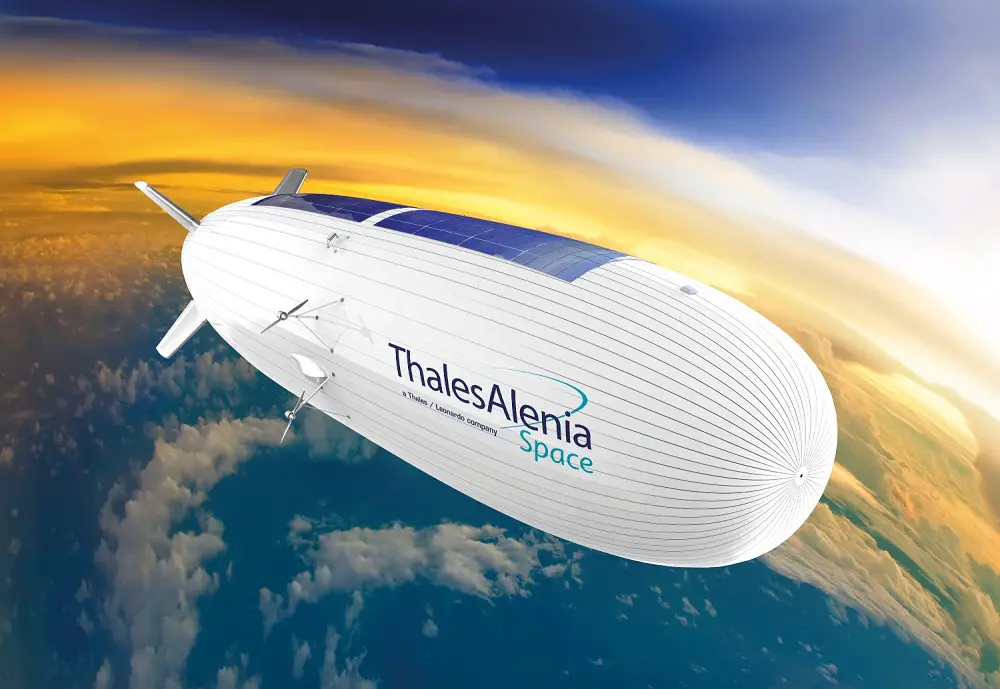Thales Alenia Space, the joint venture between Thales (67%) and Leonardo (33%), has signed a €43 million contract for the EuroHAPS (High-Altitude Platform Systems) demonstration project and announces its kickoff. EuroHAPS was selected by the European Commission on July 20, 2022 after a call for collaborative defense research and development projects from the European Defense Fund (EDF). Thales Alenia Space is coordinating the European consortium of 21 partners, and 18 subcontractors, from 11 countries handling the project. EuroHAPS aims to develop several stratospheric demonstrators for missions designed to improve intelligence, surveillance and reconnaissance (ISR) and communications capabilities. The main project partners are CIRA, Elettronica and Leonardo from Italy, ONERA and CEA from France, INTA from Spain, and ESG with TAO from Germany.
The project will conduct flight demonstrations for three types of complementary stratospheric platforms:
A reduced-scale Stratobus from Thales Alenia Space, a solar-powered airship designed for long-endurance missions and offering large payload capacity ;
A Hybrid High Altitude Airship (HHAA or tactical HAPS) from CIRA, capable of generating extra lift with a wing airfoil ;
An Autonomous Stratospheric Balloon System (ASBaS) from ESG and TAO consisting of a series of three altitude-controllable balloons.
These three types of platforms are complementary and feature very different operating times, capacity and operational restrictions. They will give Europe a broad spectrum of solutions to meet a variety of different requirements. These platforms will test a range of missions, including lidar observation to detect and classify targets at sea or on land, and for the latter the ability to detect them in environments with vegetation cover. COMmunications intelligence (COMINT) and electronic intelligence (ELINT) missions will also be tested, as well as a meshed broadband communications network for air and land players. EuroHAPS is thus reviving the use of high-altitude platform systems for government and defense missions with the support of six defense ministries (France, Italy, Spain, Germany, Hungary and the Czech Republic), the European Commission, the French Sud regional authority and the Canary Islands region, where, in addition to the ones planned in Sardinia (Italy), some demonstration flights are planned to operate from Fuerteventura island starting in 2024.
HAPS offer a new opportunity to complement ground-based, satellite-based or airborne assets with unique capabilities tailored to operational requirements. The stratosphere is a domain largely ignored until now that supports very-long-duration missions — up to one year — at relatively low altitudes (about 20 km), thus affording excellent resolution for observation missions and robust link budgets for communications missions. These flight demonstrations of HAPS will allow to demonstrate different platforms, address the main technical risks associated with these new technologies, while refining operational requirements to ultimately enable development of future HAPS systems.
Stratobus is a non-rigid stratospheric airship inflated with helium that maintains its shape through internal pressure and has its own fully autonomous electric propulsion system. The concept has been optimized around an airship about 140 meters in length, propelled by four electric motors, with more than 1,000 square meters of solar cells, and the ability to operate at altitudes of 18 to 20 kilometers (11 to 12 miles). The goal is to carry payloads of 250 kilograms (550 pounds) rated at 5 kilowatts. Numerous technical obstacles have been overcome during the development phase, notably maturing the airship’s envelope and flexible solar concentrator, envelope tear technology for safety aspects, and high-efficiency propulsion system.
Drawing on over 40 years of experience and a unique combination of skills, expertise and cultures, Thales Alenia Space delivers cost-effective solutions for telecommunications, navigation, Earth observation, environmental management, exploration, science and orbital infrastructures. Governments and private industry alike count on Thales Alenia Space to design satellite-based systems that provide anytime, anywhere connections and positioning, monitor our planet, enhance management of its resources, and explore our Solar System and beyond. Thales Alenia Space sees space as a new horizon, helping build a better, more sustainable life on Earth. A joint venture between Thales (67%) and Leonardo (33%), Thales Alenia Space also teams up with Telespazio to form the parent companies’ Space Alliance, which offers a complete range of services. Thales Alenia Space posted consolidated revenues of approximately €2.15 billion in 2022 and has around 8,000 employees in 10 countries with 17 sites in Europe and a plant in the US.















